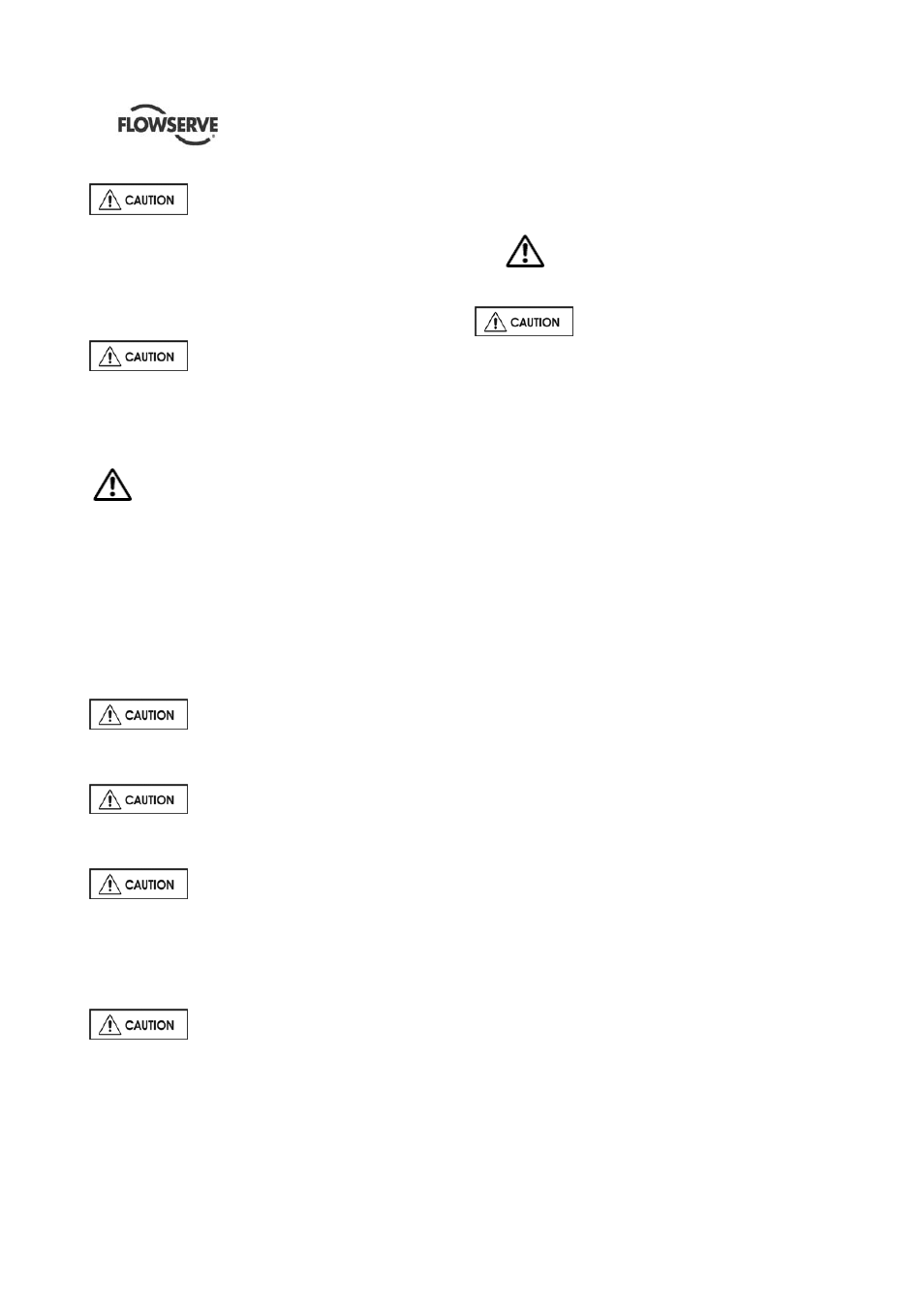Flowserve QLQ Vertical Worthington User Manual
Page 36

QLQ, QLQC USER INSTRUCTIONS ENGLISH 87900027 – 06/14
Page 36 of 61
5.5 Direction of rotation
Ensure the pump is given the same
rotation as the pump direction arrow fit on bearing
housing. In any case the direction of rotation must be
checked with the pump disconnected.
To avoid dry running the pump must either be filled
with liquid or have the flexible coupling disconnected
before driver is switched on.
If maintenance work has been carried
out to the site's electricity supply, the direction of
rotation should be re-checked as above in case the
supply phasing has been altered.
5.6 Guarding
Guarding is supplied fitted to the pump set by
captive fasteners. If this has been removed or
disturbed ensure that all the protective guards around
the pump coupling and exposed parts of the shaft are
securely fixed.
Machinery to be protected at all times by Flowserve
provided safety guards or per applicable local or
national standard. Compliance is mandatory for some
regions of the world and in explosive environments.
5.7 Priming and auxiliary supplies
Ensure electrical, hydraulic,
pneumatic, sealant and lubrication systems (as
applicable) are connected and operational.
Ensure the inlet pipe and pump casing
are completely full of liquid before starting continuous
duty.
(For Wet Pit application) Ensure that
the pump has the required Minimum Submergence
according to the value stated on the dedicated
General Arrangement Drawing.
5.8 Starting the pump
Ensure flushing and/or cooling/
heating liquid supplies are turned ON before
starting the pump.
a) CLOSE the outlet valve (or partially open in some
cases).
b) OPEN all inlet valve.
c) For wet pit application check that the liquid levels
are correct; for can pumps, ensure that the can is
filled with liquid before starting the pump
d)
Ensure all vent connections are closed
before starting.
e) Check the motor connections.
Do not run the pump with the outlet
valve closed for a period longer than 30 seconds.
5.8.1 Pre-starting checks
Before starting the pump the following checks should
be made.
b) Rotate the pump shaft by hand to make sure the
pump rotates freely and the impellers are
correctly positioned.
c) Has the electric motor been properly lubricated in
accordance with the instructions furnished with
the driver?
d) Has the electric motor been checked for proper
rotation? If not, the pump must be disconnected
from the driver at the coupling before checking.
The electric motor must rotate counter-clockwise
when looking down on the top of the driver.
e) Check all connections to the driver and control.
Do not overfill the grease cavity. Over greasing
can lead to failure of the thrust bearing.
f) Check that all piping connections are tight.
g) Check all foundation bolts for tightness.
h) Check all bolting connections for tightness
(coupling bolts, mechanical seal gland bolts,
driver bolts etc.).
i) Make sure the mechanical seal is properly
adjusted and locked into place. Ensure that all
seal spacers are in the running position prior to
operation.
j) All guards must be secured in position prior to
pump startup to prevent possible contact with
rotating parts.
To ensure proper alignment three items are very
important during installation and they are:
All machined mating surfaces (such as the
mating faces of the pump and motor) must be
clean and free from burrs and nicks.
These surfaces should be cleaned thoroughly
with a scraper, wire brush and emery cloth if
necessary and all nicks or burrs removed with a
fine file.
Exterior strain must not be transmitted to the
pump. The most common cause of trouble in
this respect is forcing the piping to mate with the
pump. It is recommended that flexible
connectors be installed in the piping adjacent to
the pump.
